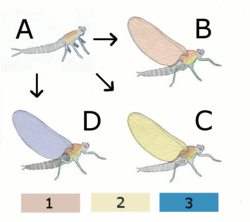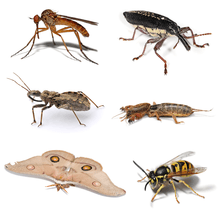Rhyniognatha
Rhyniognatha hirsti is often considered the world’s oldest known insect. It emerged very early during the Early Devonian Period, around 400 million years ago, when Earth’s first terrestrial ecosystems were being formed.
| Rhyniognatha | |
|---|---|
 | |
| A hypothetical evolutionary pathway leading to the wings believed to be present on Rhyniognatha and its descendants. | |
| Scientific classification | |
| Kingdom: | Animalia |
| Phylum: | Arthropoda |
| Class: | Insecta |
| Genus: | †Rhyniognatha Tillyard, 1928 |
| Species: | †R. hirsti |
| Binomial name | |
| †Rhyniognatha hirsti Tillyard, 1928 | |
| Synonyms | |
|
Rhyniella praecursor (partim) | |
Evidence
The head part of a specimen, preserved in a fragment of Rhynie Chert, was collected in 1919 by the Reverend W. Cran, who provided it to S. Hirst, S. Maulik and D.J. Scourfield. Hirst and Maulik published a report in 1926; in it they described Rhyniella praecursor, which is now known to be a springtail. Several other pieces, including the Rhyniognatha head, were also described as R. praecursor, stating the specimen to be a “supposed larval insect”. The specimen was correctly identified as a different species and renamed Rhyniognatha hirsti in 1928 by entomologist Robin J. Tillyard. It was later donated by D.J. Scourfield to the Natural History Museum in London where it is currently displayed on a microscope slide.[1] In 2004 Michael S. Engel and David A. Grimaldi (2004) analyzed Rhyniognatha hirsti's mouthparts, and came to the conclusion that Rhyniognatha likely had wings, as they determined the mouthparts resembled those of a mayfly, a flying insect.[2] Nevertheless, Carolin Haug & Joachim T. Haug came to a different conclusion, interpreting Rhyniognatha hirsti as a myriapod.[3]
Food
Like other insects of its time, Rhyniognatha presumably fed on plant sporophylls—which occur at the tips of branches and bear sporangia, the spore-producing organs. The insect’s anatomy might also give clues as to what it ate. The creature had large mandibles which may or may not have been used for hunting.
Wings
Engel & Grimaldi show that R. hirsti was relatively derived within early insects, sharing many characteristics with winged insects. This could mean that R. hirsti itself was already winged.[4]
References
- Andrew Ross. "The oldest fossil insect in the world". Natural History Museum.
- Engel, Michael; Grimaldi, David (12 February 2004). "New Light Shed on the Oldest Insect". Nature. 427 (6975): 627–630. doi:10.1038/nature02291.
- Carolin Haug & Joachim Haug (2017). "The presumed oldest flying insect: more likely a myriapod?". PeerJ. 5: e3402. doi:10.7717/peerj.3402. PMC 5452959. PMID 28584727.
- Engel & Grimaldi 2004: Abstract
External links
- Paul Rincon (2004-02-11). "Oldest insect delights experts". BBC News.
- The University of Aberdeen Image of type specimen (University of Aberdeen)
